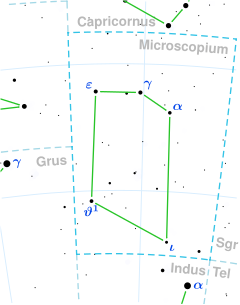| Observation data Epoch J2000 Equinox J2000 | |
|---|---|
| Constellation | Microscopium |
| Right ascension | 20h 28m 46.74360s [1] |
| Declination | −35° 35′ 45.1068″ [1] |
| Apparent magnitude (V) | 6.08±0.01 [2] |
| Characteristics | |
| Spectral type | B8 II/III [3] or B9pHgMn [4] |
| B−V color index | −0.11 [5] |
| Astrometry | |
| Radial velocity (Rv) | −9.7±1.2 [6] km/s |
| Proper motion (μ) | RA: +2.959 mas/yr [1] Dec.: −21.638 mas/yr [1] |
| Parallax (π) | 4.3936±0.0714 mas [1] |
| Distance | 740 ± 10 ly (228 ± 4 pc) |
| Absolute magnitude (MV) | −0.59 [7] or −1.10 [8] |
| Details | |
| Mass | 4.03±0.05 [1] M☉ |
| Radius | 4.19±0.21 [9] R☉ |
| Luminosity | 390±12 [1] L☉ |
| Surface gravity (log g) | 3.75 [10] cgs |
| Temperature | 14,028 [8] K |
| Metallicity [Fe/H] | −0.20 [10] dex |
| Rotation | 6 d [11] |
| Rotational velocity (v sin i) | ≤30 [11] km/s |
| Age | 70 [8] Myr |
| Other designations | |
| 2 G. Microscopii [12] , CD−36°14166, CPD−36°9170, FK5 3637, GC 28464, HD 194783, HIP 101017, HR 7817, SAO 212160, TIC 34864575 [13] | |
| Database references | |
| SIMBAD | data |
HD 194783 (HR 7817; 2 G. Microscopii) is a solitary star located in the southern constellation of Microscopium near the border with Sagittarius. It is barely visible to the naked eye as a bluish-white-hued point of light with an apparent magnitude of 6.08. [2] The object is located relatively far at a distance of 740 light-years based on Gaia DR3 parallax measurements, [1] but it is drifting closer with a heliocentric radial velocity of −9.7 km/s . [6] At its current distance, HD 194783's brightness is diminished by an interstellar extinction of 0.31 magnitudes [14] and it has an absolute magnitude of either −0.59 or −1.10, [7] [8] depending on the source.
HD 194783 has a stellar classification of B8 II/III, [3] indicating that it is an evolved B-type star with the blended luminosity class of a bright giant and a lower luminosity giant star. It has also been given a class of B9pHgMn, [4] indicating that it is a chemically peculiar mercury-manganese star. It has 4.03 times the mass of the Sun [1] and a slightly enlarged radius 4.19 times that of the Sun's. [9] It radiates 390 times the luminosity of the Sun [1] from its photosphere at an effective temperature of 14,028 K . [8] The heavy metal (iron) to hydrogen ratio–what astronomers dub as the star's metallicity–is 63% that of the Sun's. [10] HD 194783 is estimated to be approximately 70 million years old. [8]
In 1989, HD 194783 was reported to be a spectrum variable with a period of 6 days. The projected rotational velocity of the star is not known, but it is said to be no higher than 30 km/s . [11] HD 194783 was also observed to have a relatively weak magnetic field of about −43 gauss. [15]
